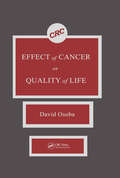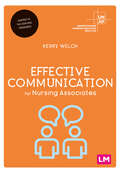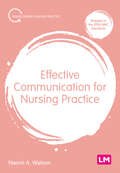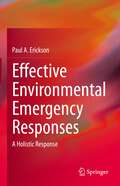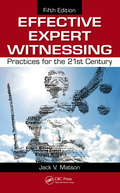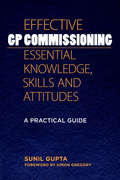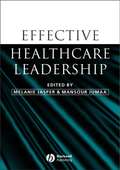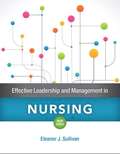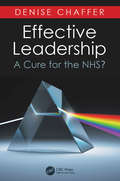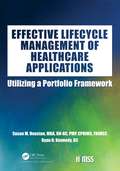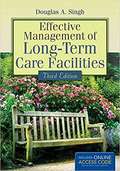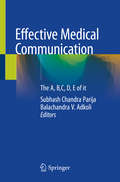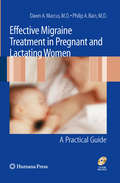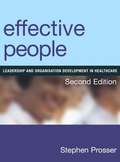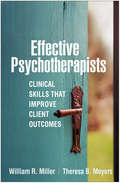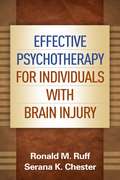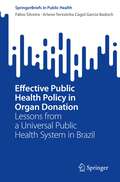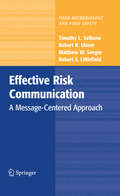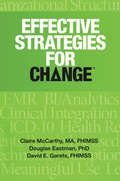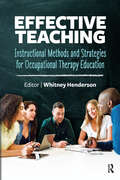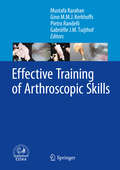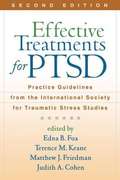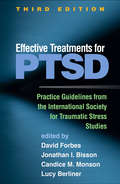- Table View
- List View
Effect of Cancer On Quality of Life
by David OsobaThis book is comprised of extensive reviews and instructional chapters that discuss the quality of life in several aspects of cancer. The first six chapters deal with conceptual issues relating to measuring quality of life in adult and pediatric populations with cancer. The next five chapters provide practical information on how to select quality-of-life measures, the statistical analysis of trials, economic evaluations to be considered, and some possible abuses of quality-of-life measures. Five chapters review the results of studies using selected quality-of-life measures and provide recent information on their performance. These are followed by three chapters dealing with specific issues relating to nausea and vomiting associated with cancer therapy. Three chapters are devoted to the problems of assessing and controlling pain in patients who have cancer. There are also two chapters that deal with the quality of life in palliative care. Effect of Cancer on Quality of Life is intended for all who have an interest in measuring the quality of life in patients with cancer. This includes investigators who are just entering the field and can benefit from instructions on how to conduct quality-of-life research, as well as those who are experienced in conducting this kind of research.
Effective Communication for Nursing Associates (Understanding Nursing Associate Practice)
by Kerry WelchCommunication is central to providing high quality, person-centred care as a Nursing Associate. This book will help you to communicate effectively with patients, families, carers and your interprofessional team, encouraging you to develop your own unique voice. Covering important topics such as professional communication, tackling difficult conversations, communicating with emotional intelligence and tailoring communication across diverse settings, this book will enable you to communicate confidently in any situation. Key features - Fully mapped to the NMC Standards of Proficiency for Nursing Associates (2018) - Case studies, activities and other learning features help you master your skills - Focussed specifically on the Nursing Associate role, helping you develop into a confident professional practitioner
Effective Communication for Nursing Associates (Understanding Nursing Associate Practice)
by Kerry WelchCommunication is central to providing high quality, person-centred care as a Nursing Associate. This book will help you to communicate effectively with patients, families, carers and your interprofessional team, encouraging you to develop your own unique voice. Covering important topics such as professional communication, tackling difficult conversations, communicating with emotional intelligence and tailoring communication across diverse settings, this book will enable you to communicate confidently in any situation. Key features - Fully mapped to the NMC Standards of Proficiency for Nursing Associates (2018) - Case studies, activities and other learning features help you master your skills - Focussed specifically on the Nursing Associate role, helping you develop into a confident professional practitioner
Effective Communication for Nursing Practice (Transforming Nursing Practice Series)
by Naomi Anna WatsonEffective communication is at the heart of the nursing role. From providing person-centred care to collaborating with the multi-disciplinary team, this book will develop your communication and interpersonal skills and support you in finding your own voice. It equips you with key theory and principles and shows how to apply them to practice, from communicating with compassion to overcoming barriers to communication. This is your go to guide for effective communication in your everyday practice. Key features: · Each chapter is mapped to the 2018 NMC Standards · Takes a lifespan approach, covering communication with different groups across all fields of practice · Content and examples explore communication in relation to diversity, equity and inclusion, encouraging culturally competent and emotionally intelligent practice · Filled with activities and case studies to support critical thinking, reflection and application of theory to everyday nursing practice
Effective Communication for Nursing Practice (Transforming Nursing Practice Series)
by Naomi Anna WatsonEffective communication is at the heart of the nursing role. From providing person-centred care to collaborating with the multi-disciplinary team, this book will develop your communication and interpersonal skills and support you in finding your own voice. It equips you with key theory and principles and shows how to apply them to practice, from communicating with compassion to overcoming barriers to communication. This is your go to guide for effective communication in your everyday practice. Key features: · Each chapter is mapped to the 2018 NMC Standards · Takes a lifespan approach, covering communication with different groups across all fields of practice · Content and examples explore communication in relation to diversity, equity and inclusion, encouraging culturally competent and emotionally intelligent practice · Filled with activities and case studies to support critical thinking, reflection and application of theory to everyday nursing practice
Effective Environmental Emergency Responses: A Holistic Response
by Paul A. EricksonThis book focuses on the variety of subsequent consequences that may follow the conclusion of the immediate emergency response effort, consequences that require multi-disciplinary efforts and most likely may require a revamping of the historical interplay of national and other political authorities. The book is essentially a critique of contemporary emergency response which, in both the public perception and, unfortunately, in the mind-set of many practicing professionals emphasizes an emergency as a singular event. It is a mistaken view: an emergency is actually a sequence of multiple, singular events that unfold over time, sometimes measured in days and weeks and, most often, in months, years and decades. This book focuses on the need, in the current and recent past generation to revamp our thinking about planning for and responding comprehensively to those periodic disruptions to daily routine we call "emergencies".
Effective Expert Witnessing: Practices for the 21st Century (Routledge Revivals Ser.)
by Jack V. Matson S. Ravi JagannathanThe testimony of an expert witness can lead to success or failure in cases that hinge on the presentation‘s impact on a jury. Effective Expert Witnessing, Fifth Edition: Practices for the 21st Century explores the fundamentals of litigation, trial preparation, courtroom presentation, and the business of expert witnessing. Extensively updated to ref
Effective GP Commissioning - Essential Knowledge, Skills and Attitudes: A Practical Guide
by Sunil GuptaThe proposed abolition of Primary Care Trusts and transfer of their commissioning functions to GP consortia have been greeted with intense excitement by some GPs, and with extreme trepidation by others. This book explains what commissioning is and how to do it, enabling clinicians to flourish as commissioners in the new NHS. Some topics that will be familiar to readers, such as long term conditions management, patient safety and the wider determinants of health, are explored here from a commissioning perspective. Others which may be less familiar, such as how to delegate, how to improve productivity, management theories and the content of financial accounts, are explored in detail. Additional skills needed by commissioning GPs - fostering innovation, assertiveness and emotional competence as well as negotiation, presentation and even media management skills - are outlined in a clear and straightforward fashion, while the necessary attitudes involved are described with reference to the Nolan Principles of Public Life. A straightforward yet comprehensive guide, Effective GP Commissioning - Essential Knowledge, Skills and Attitudes will be essential for GPs, prospective GPs, and those with an interest in effective commissioning. 'A useful resource for all GPs whatever their level of engagement and indeed for non-clinicians also. Sunil Gupta is clearly a GP and business magpie who has an incredible ability to gather, organise and present useful information. The content of this book is well-researched linking considerable volumes of information in a very useful, constructive manner.' - From the Foreword by Simon Gregory
Effective Healthcare Leadership
by Mansour Jumaa Melanie JasperEffective Healthcare Leadership integrates theory and practice to distil the reality of healthcare leadership today. It addresses the context and explores strategies for leadership and examines the leadership skills required to implement and sustain developments in healthcare. Section one examines the contemporary context and challenges of healthcare leadership. Section two offers opportunities through the CLINLAP/LEADLAP model to see how modern management ideas, tools and techniques are used effectively in leadership development. Section three examines the role of leadership in implementing change and improving practice in different contexts of care. The final section explores future challenges in leadership.
Effective Leadership and Management in Nursing
by Eleanor J. SullivanMore than ever before, today’s rapidly changing, volatile healthcare environment demands highly developed management skills and superb leadership. Effective Leadership and Management in Nursing will help both practicing and student nurses manage successfully today, as well as into the future. This book combines practicality with conceptual understanding, tapping expertise of contributors from many relevant disciplines, especially healthcare management professionals. Updated to reflect the current state of healthcare, the 9th edition offers new or expanded coverage of the Affordable Care Act; evolving models of healthcare; cultural and gender diversity; quality management; emotional leadership; social media; harassing, bullying, and lack of civility in healthcare; emergency preparedness for terrorism, disasters, and mass shootings; and prevention of workplace violence. Two new chapters round out this award-winning text: “Understanding Legal and Ethical Issues” and “Imagining the Future.”
Effective Leadership: A Cure for the NHS?
by Denise ChafferWhile the investigations and reports which have followed recent health care scandals in the UK have highlighted the very important issue of addressing organizational culture and the need for more effective leadership at every level, patients and their families have struggled to comprehend how such things can occur in a health service that is suppos
Effective Lifecycle Management of Healthcare Applications: Utilizing a Portfolio Framework (HIMSS Book Series)
by Susan M. Houston Ryan D. KennedyThe rapid growth of software applications within healthcare organizations has made it essential to have defined methodologies and formal processes for the management of the entire Information Technology (IT) portfolio. Utilizing a portfolio management framework throughout an application’s lifecycle will provide the necessary structure to ensure that all new applications are properly evaluated, and, once implemented, remain relevant while continuing to meet organizational requirements. While an organization may have a few large "organization-wide" systems such as the Electronic Health Record (EHR), lab or radiology systems, they also have a large quantity of other clinical, administrative, and research systems. Some larger organizations now have hundreds of software applications to support and manage. The IT staff must be able to implement new requests while still maintaining the current application portfolio. Utilizing a standard repeatable process will help to manage these large portfolios of software applications. This book reviews the management of applications throughout their lifecycle, from initial request through disposition. Best practices dictate that every newly requested application undergoes analysis followed by an approval decision from the organization’s governance committee. The initial implementation project must include activities to prepare for ongoing support while ensuring the application is compliant with all security, privacy, and architecture requirements. An application spends years in operations and maintenance where changes occur regularly through configuration and release management, or additional projects. The cycle continues until disposition. Understanding when to dispose of an application is just as important as deciding when to implement a new one. A defined process for disposing of an application ensures all parts are properly removed or destroyed.
Effective Management Of Long-Term Care Facilities
by Douglas A. SinghEffective Management of Long-Term Care Facilities, Third Edition examines the complex operations of the long-term care facility and offers critical skills to current and future long-term care administrators for delivering quality, cost-effective services. Comprehensive, yet concise, the Third Edition explores the necessary skills and tools for creating a person-centered environment. <P><P>Topics covered include: how to adapt an existing nursing facility, the growing culture change movement, and the laws, regulations, and financing of the long-term care industry, as well as its organization and delivery. Finally, this book offers extensive coverage of the essential skills necessary to manage it all. Designed for graduate or senior-level undergraduate courses, this book also serves as an excellent reference for practicing administrators, corporate officers, and governing board members. Key Features: - Offers an overview of the long-term care system and a detailed exploration of its laws, regulations, and financing; organization and services; as well as essentials of effective business management within the long-term care environment - Includes a final section with 12 real-world case studies for further discussion, analysis, and application of the concepts presented in the previous chapters - Thoroughly updated with current research findings and data as well as coverage of the Affordable Care Act (ACA), as it pertains to long-term care
Effective Medical Communication: The A, B,C, D, E of it
by Subhash Chandra Parija Balachandra V. AdkoliEffective communication is at the heart of medical profession, whether it is patient-doctor communication, interpersonal communication, or communication with the scientific and research community. However, medical professionals are not adequately trained in these skills, and when it comes to presentations, the message is often lost due to inadequate preparation, ineffective slides, and a generally unconvincing performance by the presenter. This book addresses all aspects of the communication skills required by individuals entering medical school as well as professionals farther up the career ladder. Each chapter offers a quote or a statement that captures the essence of the text. Adopting a unique approach known an A, B, C, D and E (Assess Need, Brief, Contextualize, Describe and Evaluate) the book includes abundant illustrations, real-world case scenarios, anecdotes, tables, graphs and cartoons, as well as practical information, and tips on communicating effectively. As such it is a valuable resource for new and experienced clinicians, educators and researchers wanting to improve their communications skills.
Effective Migraine Treatment in Pregnant and Lactating Women: A Practical Guide
by Philip A. Bain Dawn MarcusMore than 28 million Americans suffer from migraine headaches, with migraine affecting nearly one in five women in their reproductive years. Effective Migraine Treatment in Pregnant and Lactating Women: A Practical Guide, provides a comprehensive resource to address diagnosis, testing, and treatment of headaches in reproductively fertile women. This important new book offers a wealth of practical, ready-to-use, clinically tested tips and recommendations to treat women with headaches during pregnancy and nursing. Although women may ideally prefer to restrict migraine treatments during pregnancy, up to one in three pregnant women self-medicate for symptoms, especially with analgesics. Fortunately, there are many effective treatment options that can be safely used when pregnant and breastfeeding. Available therapies include medication and nonmedication treatments, traditional and alternative therapies, and nutritional supplements. This book uniquely answers frequently asked questions by patients and offers healthcare providers easy-to-use office tools for patient education and charting documentation. The authors of this important new work have collaborated to provide a resource that will help clinicians provide women with the tools and knowledge to become empowered and to gain control over their migraines when trying to conceive, during pregnancy, and when nursing.
Effective People: Leadership and Organisation Development in Healthcare, Second Edition
by Stephen Prosser'In these pages you will find a rich mixture of the best in leadership and organisation development practice and theory, based on a lifetime of studying and applying the principles of why some healthcare organisations succeed and why some fail.' This inspirational book analyses the attitudes and disciplines which make people and the organizations for which they work more effective, more productive and generally more successful. The author, who has experience of working in healthcare and manufacturing and with senior civil servants, and is also familiar with key academic literature, sets out a highly practical combination of practice, theory and policy applicable in a wide variety of healthcare situations. Now revised, including an entirely new chapter on being patient-focused, this remains an invaluable resource for health service leaders and future leaders including managers, clinicians, policy makers and academics.
Effective Psychotherapists: Clinical Skills That Improve Client Outcomes
by William R. Miller Theresa B. MoyersWhat is it that makes some therapists so much more effective than others, even when they are delivering the same evidence-based treatment? This instructive book identifies specific interpersonal skills and attitudes--often overlooked in clinical training--that facilitate better client outcomes across a broad range of treatment methods and contexts. Reviewing 70 years of psychotherapy research, the preeminent authors show that empathy, acceptance, warmth, focus, and other characteristics of effective therapists are both measurable and teachable. Richly illustrated with annotated sample dialogues, the book gives practitioners and students a blueprint for learning, practicing, and self-monitoring these crucial clinical skills.
Effective Psychotherapy for Individuals with Brain Injury
by Ronald M. Ruff Serana K. ChesterCombining scientific expertise with psychotherapeutic acumen, this book is highly accessible and packed with clinical tools. Part I provides essential information on how acquired brain injury affects emotional functioning. Part II describes practical, specially tailored ways to treat anxiety, depression, and anger related to brain damage, and to help patients regain a sense of meaning and value in their lives. The book shows how standard psychotherapeutic interventions can be adapted for the brain-injured population, as well as which approaches may be contraindicated. It presents a biopsychosocial framework for assessment and treatment that integrates emotional support, cognitive-behavioral techniques, and acceptance- and mindfulness-based strategies.
Effective Public Health Policy in Organ Donation: Lessons from a Universal Public Health System in Brazil (SpringerBriefs in Public Health)
by Fábio Silveira Arlene Terezinha BadochThis book shows how a successful public health policy designed to foster the culture of brain death diagnosis and improve the interaction between Organ Procurement Organizations and Intra-Hospital Organ and Tissue Donation Committees for Transplants led the Brazilian state of Paraná to reach one of the highest rates of effective organ donors per million population in the world. Brazil has the largest public transplant system in the world, and each of the country’s 26 states is responsible for organizing its own transplant system. The state of Paraná, with 11 million inhabitants, has stood out in this regard in the last decade. It reached 47.7 effective donors per million population (pmp), performing better than countries such as the United States (33.3/pmp), Canada (21.9/pmp), Portugal (33.6/pmp) and Croatia (41.2/pmp). The remodeling of Paraná’s transplant system, between 2011 and 2020, was based on the recognized Spanish model, but has some unique characteristics. This book seeks to describe all the steps of this remodeling, describing its characteristics and explaining how the new system was built. By presenting an in-depth analysis of a local successful case, Effective Public Health Policy in Organ Donation: Lessons from a Universal Public Health System in Brazil seeks to provide useful information to policy makers, health professionals and students from different fields within the health sciences interested in understanding how public health policies can improve organ donation rates, especially in developing countries.
Effective Risk Communication
by Robert Littlefield Robert R. Ulmer Matthew W. Seeger Timothy L. SellnowThe overlying purpose of this book is to construct a communication based approach to risk communication. In doing so, this book establishes a message-centered focus to risk communication. Section one of the book establishes definitions and parameters of risk communication, identifies the complex audience expectations for risk messages, and introduces a model of best practices for effective risk communication. In section two, the best practices are applied in four robust case studies. Section three includes chapters devoted to developing a mindful approach to risk communication, ethical considerations of risk communication, and a final chapter that discusses future developments of risk communication.
Effective Strategies for Change (HIMSS Book Series)
by Claire McCarthy Dave Garets Doug EastmanEffective Strategies for Change is a newly revised edition of HIMSS' bestseller Change Management Strategies for an Effective EMR Implementation. Published in 2009, Change Management Strategies prepared readers to lead or participate successfully in change management/technology adoption efforts to achieve meaningful use of EMRs. The authors provided successful strategies to plan and implement change-based on their decades of combined experience managing the people side of implementation.This revised edition explores how healthcare has changed since the first edition was published. It equips readers with the tools to create an environment for success in their organizations that not only ensures EMR, ICD-10 or clinical integration efforts are successful, but that organizations can build change capacity and flexibility in the process. The authors provide concepts and methodologies applicable to both large and small healthcare organizations, as well as lessons learned from healthcare stakeholders who utilized tactics from the first edition in their organizations' EMR implementations.
Effective Teaching: Instructional Methods and Strategies for Occupational Therapy Education
by Whitney HendersonGrounded in research and experience, Effective Teaching: Instructional Methods and Strategies for Occupational Therapy Education offers practical examples of various types of instructional methods and theoretical models for educators in occupational therapy and other allied health professions to use in evidence-based teaching. Dr. Whitney Henderson includes the latest trends and methods used in education to facilitate student-centered learning. With an easy-to-understand overview of each technique presented, allied health educators can follow step-by-step details to implement various evidence-based instructional methods. Each chapter of Effective Teaching contains: Description of the instructional method Evidence supporting use of the method Discussion of a learning theory and how the method relates to this theory Discussion of how to use the method to develop clinical reasoning Advantages and disadvantages of the method Examples of classroom use Application of the method to a professional situation With excellent explanations of theoretical foundations, ‘how-to’ methods and models, and strategies for educators to employ, Effective Teaching: Instructional Methods and Strategies for Occupational Therapy Education is a one-stop shop for implementing unique and useful instructional methods in educational courses.
Effective Training of Arthroscopic Skills
by Mustafa Karahan Gino M.M.J. Kerkhoffs Pietro Randelli Gabriëlle J.M. TuijthofThis book explains how training in arthroscopic skills is best carried out in order to keep up to date with advances in arthroscopy, meet the ever-increasing demand for high-quality care, and respond to changes in available training time. State of the art developments regarding tools, performance monitoring, and learning strategies are presented, and practical guidelines provided for direct implementation in daily clinical practice. The coverage of simulation-based training ranges from the use of wet labs and box trainers through to sophisticated virtual reality simulators. Subsequent sections on objective performance tracking of training outside and in the operating room cover a variety of key aspects, including performance measures, evidence-based thresholds, preclinical training strategies, and the role of global rating scales, for objective monitoring. Readers will find the book invaluable in improving the efficiency and effectiveness of arthroscopic training.
Effective Treatments for PTSD, Second Edition
by Edna Foa Terence KeaneDeveloped under the auspices of the PTSD Treatment Guidelines Task Force of the International Society for Traumatic Stress Studies, this tightly edited work is the definitive best-practice reference for practitioners caring for any trauma population. Leading clinical scientists thoroughly review the literature on widely used therapeutic approaches for both adults and children. Succinct treatment guidelines are presented that feature standardized ratings of the evidence for each approach. The book also offers insightful guidance to help clinicians select the most suitable therapy for particular patients and overcome frequently encountered obstacles. New to This Edition Expanded with six additional chapters on child and adolescent treatments. Adult chapters thoroughly revised to reflect the rapidly growing evidence base. Chapter on treating other psychiatric problems that co-occur with PTSD.More coverage of early intervention and prevention.
Effective Treatments for PTSD, Third Edition: Practice Guidelines from the International Society for Traumatic Stress Studies
by David Forbes, Jonathan I. Bisson, Candice M. Monson, Lucy BerlinerGrounded in the updated Posttraumatic Stress Disorder Prevention and Treatment Guidelines of the International Society for Traumatic Stress Studies (ISTSS), the third edition of this definitive work has more than 90% new content. Chapters describe PTSD assessment and intervention practices that have been shown to work and provide practical, real-world implementation guidance. Foremost authorities address the complexities of trauma treatment with adults, adolescents, and children in diverse clinical contexts. The book delves into common obstacles and ways to overcome them, when to stop trying a particular approach with a client, and what to do next. Special topics include transdiagnostic interventions for PTSD and co-occurring problems, dissemination challenges, and analyzing the cost-effectiveness of treatments. Prior edition editors: Edna B. Foa, Terence M. Keane, Matthew J. Friedman, and Judith A. Cohen. New to This Edition *Fully rewritten to reflect over a decade of clinical, empirical, and theoretical developments, as well as changes in DSM-5 and ICD-11. *Increased research-to-practice focus--helps the clinician apply the recommendations in specific clinical situations. *New chapters on previously covered treatments: early interventions, psychopharmacotherapy for adults and children, and EMDR therapy. *Chapters on additional treatments: prolonged exposure, cognitive processing therapy, cognitive therapy, combined psychotherapy and medication, e-mental health, and complementary and alternative approaches. *Chapters on cutting-edge topics, including personalized interventions and advances in implementation science.
